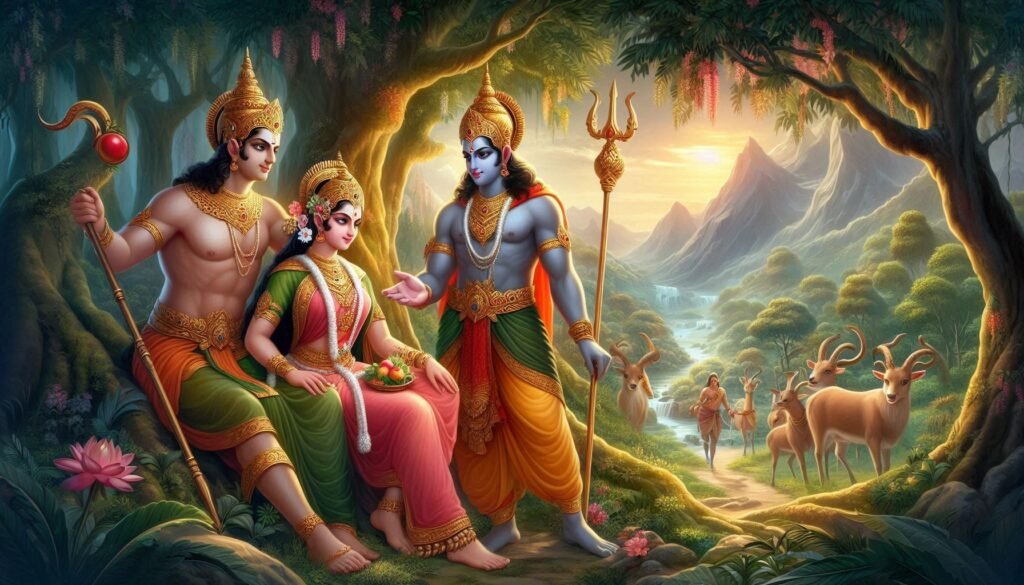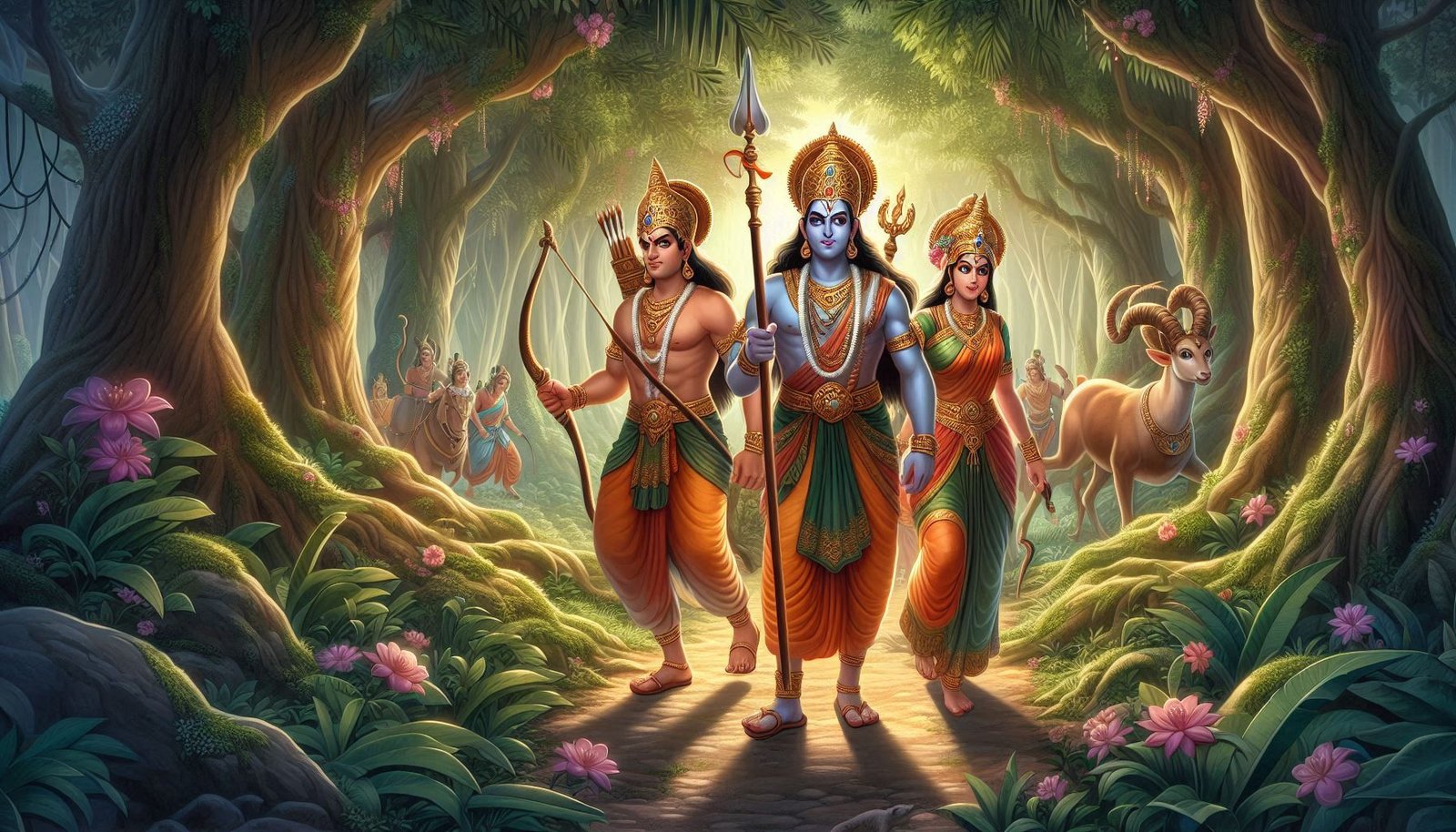The Ramayana, one of the two great Indian epics, is more than just an ancient story. It is a treasure trove of moral, ethical, and spiritual teachings. Among the various sections of this epic, the Ayodhya Kand stands out for its rich portrayal of the ideals of Dharma (righteous duty) and Karma (the law of cause and effect). The Ayodhya Kand, which recounts the exile of Lord Rama, the rightful heir to the throne of Ayodhya, offers profound lessons on how Dharma and Karma shape the course of human life. This article explores the intricate relationship between these two principles as seen through the events and characters of Ayodhya Kand.
Dharma and Karma
Dharma: The Foundation of Moral Order
Dharma is one of the most important concepts in Hindu philosophy, embodying the principles of righteousness, duty, law, and justice. In the context of the Ramayana, Dharma is the guiding force behind the actions of its characters. It is not merely a set of rules but a way of life that governs the social, ethical, and cosmic order. The Ramayana illustrates how adherence to Dharma can maintain balance in the world, while deviation from it can lead to chaos.
In Ayodhya Kand, the concept of Dharma is explored from various angles—through the responsibilities of kingship, the duties of a son, the role of a wife, and the expectations of a ruler. Every major character in this section of the Ramayana faces a Dharma dilemma, forcing them to make choices that reflect their understanding of righteousness.
Rama’s Dharma: The Epitome of Righteousness
Lord Rama, the protagonist of the Ramayana, is often referred to as Maryada Purushottam—the ideal man. His life is a model of perfect adherence to Dharma. In Ayodhya Kand, when his father, King Dasharatha, announces that Rama will be crowned as the next king, the entire kingdom rejoices. However, this joy is short-lived as Kaikeyi, one of Dasharatha’s queens, demands that Rama be exiled for 14 years and her son Bharata be made king instead.
Rama’s response to this sudden and unfair demand is a testament to his unwavering commitment to Dharma. Despite knowing that he is the rightful heir and that his exile is the result of Kaikeyi’s manipulation, Rama accepts his fate without question. He believes that upholding his father’s word is paramount to maintaining Dharma, even if it brings personal suffering.
By accepting his exile, Rama demonstrates that Dharma is not always about personal benefit; it is about fulfilling one’s duty, even when it is painful. His decision reflects the idea that Dharma often involves sacrifice and selflessness. Rama’s actions show that true righteousness transcends personal desires, and adhering to Dharma can have far-reaching positive consequences, even if the immediate outcome seems unfavorable.
Dasharatha’s Dharma: The King’s Dilemma
King Dasharatha, the ruler of Ayodhya, is a key figure in the Ayodhya Kand, and his actions highlight the complexities of Dharma. He is bound by a promise he made to Kaikeyi years ago when she saved his life. At that time, he offered her two boons, which she could claim at any point in the future. When Kaikeyi uses these boons to demand Rama’s exile and Bharata’s ascension to the throne, Dasharatha is plunged into a moral crisis.

As a father, Dasharatha loves Rama dearly and wishes for him to be king. However, as a ruler, he must keep his word, for a king’s promise is sacred and cannot be broken. This conflict between personal affection and royal duty is one of the most poignant moments in the Ramayana. Dasharatha’s heart breaks at the thought of sending Rama away, but he is bound by Dharma to honor his promise to Kaikeyi.
This episode reveals that Dharma is not always clear-cut. Dasharatha’s adherence to his promise leads to great personal suffering, but it also reinforces the importance of keeping one’s word, particularly for those in positions of power. In many ways, Dasharatha’s dilemma mirrors the ethical challenges that leaders face in balancing personal desires with public responsibilities.
Kaikeyi’s Misguided Dharma: The Role of Personal Desire
Kaikeyi, one of Dasharatha’s queens, is a character whose actions challenge our understanding of Dharma. Initially, she is portrayed as a loving and devoted wife and stepmother to Rama. However, under the influence of her maid Manthara, she becomes consumed by the desire to secure the throne for her own son, Bharata. Kaikeyi invokes the boons Dasharatha promised her, demanding Rama’s exile and Bharata’s coronation.
From Kaikeyi’s perspective, her actions are motivated by a sense of duty toward her son. She believes that securing the throne for Bharata is her Dharmic duty as a mother. However, her understanding of Dharma is clouded by selfish desires and manipulation. In pursuing her personal ambitions, she disrupts the moral and social order of the kingdom, leading to widespread grief and suffering.
Kaikeyi’s story serves as a cautionary tale about the dangers of misinterpreting Dharma. When Dharma is influenced by personal gain rather than universal principles of righteousness, it leads to negative consequences. Kaikeyi’s actions, though seemingly motivated by maternal love, are ultimately driven by ego and attachment, which cause harm not only to others but to herself as well. Her character illustrates that true Dharma must be aligned with the greater good, not individual desires.
Karma: The Law of Cause and Effect
The concept of Karma—the law of cause and effect—is deeply intertwined with the idea of Dharma in the Ramayana. According to the principle of Karma, every action (whether good or bad) has consequences that manifest either in this life or future lives. In Ayodhya Kand, the unfolding events can be seen as the result of the characters’ past actions, demonstrating how Karma shapes destiny.
Dharma and Karma
Dasharatha’s Karma: The Burden of the Past
One of the most striking examples of Karma in Ayodhya Kand is the fate of King Dasharatha. In his youth, Dasharatha accidentally killed Shravan Kumar, a young boy who was carrying his blind parents on a pilgrimage. Mistaking Shravan for an animal while hunting, Dasharatha shot him with an arrow. Before dying, Shravan’s parents cursed Dasharatha, saying that he too would experience the pain of losing his beloved son.
Dasharatha’s tragic separation from Rama can be seen as the fulfillment of this curse. His suffering is a direct result of his past Karma, even though the action was unintentional. This episode illustrates the principle that Karma is impartial—it operates according to the actions performed, regardless of intent. The law of Karma ensures that every action has a consequence, and Dasharatha’s past mistake comes back to haunt him in the form of Rama’s exile.
Rama’s Karma: The Noble Response to Adversity
Rama’s exile, though seemingly unfair, can also be understood through the lens of Karma. As the seventh avatar of Vishnu, Rama’s mission on Earth is to restore Dharma by defeating evil forces, particularly the demon king Ravana. His exile sets in motion the events that will ultimately lead to this divine purpose.
While Rama’s exile may appear to be a consequence of the negative Karma of others (such as Kaikeyi and Dasharatha), his noble response to adversity generates positive Karma. By accepting his fate with grace and maintaining his commitment to Dharma, Rama ensures that his future actions will lead to righteousness and the welfare of all.
Rama’s journey in the forest, alongside his wife Sita and brother Lakshmana, is filled with trials and tribulations. However, these challenges serve to strengthen his character and prepare him for the greater task of defeating Ravana. In this sense, Rama’s exile is not a punishment but an opportunity for spiritual growth and the fulfillment of his divine mission.
Kaikeyi’s Karma: The Consequences of Selfish Actions
Kaikeyi’s actions in demanding Rama’s exile are motivated by selfish desires, and as a result, she accrues negative Karma. While she initially believes that securing the throne for Bharata will bring her happiness, the opposite occurs. Bharata refuses to accept the throne, condemning his mother for her actions. Kaikeyi is left isolated and regretful, having lost the love and respect of her family and kingdom.
Her story demonstrates that selfish actions, even when justified by misguided notions of duty, lead to suffering. Kaikeyi’s manipulation and greed not only harm those around her but also result in her own emotional and spiritual downfall. In the end, she must face the consequences of her Karma, realizing too late that her actions have brought her only misery.
The Interplay of Dharma and Karma in Ayodhya Kand
The events of Ayodhya Kand illustrate the intricate relationship between Dharma and Karma. Dharma guides individuals in performing righteous actions, while Karma ensures that those actions—whether good or bad—have consequences. Together, these two principles create the framework for moral and ethical behavior in the Ramayana.
In Ayodhya Kand, the characters’ adherence to or deviation from Dharma directly influences their Karma. Rama’s commitment to Dharma generates positive Karma, while Kaikeyi’s selfishness leads to negative consequences. Dasharatha’s past actions come back to affect his present, demonstrating the inescapable nature of Karma.
The story also shows that Dharma and Karma are not isolated concepts—they are deeply interconnected. One’s Dharma shapes their actions, and those actions, in turn, shape their Karma. By adhering to Dharma, individuals can create positive Karma that will lead to future well-being. Conversely, when one strays from Dharma, they accumulate negative Karma that will eventually result in suffering.
Contemporary Lessons from Ayodhya Kand
The lessons of Dharma and Karma from Ayodhya Kand are not limited to the ancient world; they have profound relevance in today’s society. In a world filled with ethical dilemmas, personal ambitions, and conflicting responsibilities, the principles of Dharma and Karma offer guidance on how to navigate life’s challenges.
- The Importance of Duty: Rama’s adherence to Dharma, despite the personal cost, serves as a reminder that duty and righteousness should guide our actions, even when the path is difficult. Whether in our personal relationships, professional lives, or social responsibilities, living in accordance with Dharma creates harmony and balance.
- The Consequences of Actions: The law of Karma teaches us that every action has consequences. Whether we are aware of it or not, our choices today will shape our future. By making ethical decisions and acting with integrity, we can create positive Karma that will lead to long-term well-being.
- Selflessness vs. Selfishness: Kaikeyi’s downfall illustrates the dangers of self-centered actions. In a world that often promotes individual success at the expense of others, the Ramayana reminds us that true happiness and fulfillment come from acting selflessly and considering the greater good.
Conclusion: The Timeless Wisdom of Dharma and Karma
The Ayodhya Kand of the Ramayana offers timeless insights into the nature of Dharma and Karma. Through the actions of Rama, Dasharatha, Kaikeyi, and other characters, we see how these two principles govern human life and destiny. Dharma provides the moral compass that guides our actions, while Karma ensures that those actions have consequences, shaping our present and future.
In a modern world filled with complexity and uncertainty, the lessons of Dharma and Karma offer a roadmap for living a life of integrity, responsibility, and purpose. By embracing these principles, we can navigate the challenges of life with wisdom and grace, ensuring that our actions contribute to the greater good and lead to lasting happiness.

